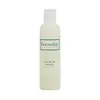What's inside
What's inside
 Key Ingredients
Key Ingredients

No key ingredients
 Benefits
Benefits

 Concerns
Concerns

 Ingredients Side-by-side
Ingredients Side-by-side

Water
Skin ConditioningCocamidopropyl Betaine
CleansingGlycerin
HumectantDecyl Glucoside
CleansingLauryl Glucoside
CleansingXanthan Gum
EmulsifyingGlycyrrhiza Glabra Root Extract
BleachingFomes Officinalis Extract
Skin ProtectingCamellia Oleifera Leaf Extract
AstringentPanthenol
Skin ConditioningDisodium EDTA
Hamamelis Virginiana Water
AstringentCitric Acid
BufferingAlcohol
AntimicrobialButylene Glycol
HumectantPotassium Sorbate
PreservativePhenoxyethanol
PreservativeEthylhexylglycerin
Skin ConditioningWater, Cocamidopropyl Betaine, Glycerin, Decyl Glucoside, Lauryl Glucoside, Xanthan Gum, Glycyrrhiza Glabra Root Extract, Fomes Officinalis Extract, Camellia Oleifera Leaf Extract, Panthenol, Disodium EDTA, Hamamelis Virginiana Water, Citric Acid, Alcohol, Butylene Glycol, Potassium Sorbate, Phenoxyethanol, Ethylhexylglycerin
Water
Skin ConditioningCetearyl Ethylhexanoate
EmollientCaprylic/Capric Triglyceride
MaskingTriisononanoin
Skin ConditioningPentylene Glycol
Skin ConditioningAmmonium Acryloyldimethyltaurate/Carboxyethyl Acrylate Crosspolymer
Cetearyl Alcohol
EmollientPrunus Amygdalus Dulcis Oil
Skin ConditioningPrunus Amygdalus Dulcis Fruit Extract
Skin ConditioningVanilla Planifolia Fruit Extract
Skin ConditioningGlyceryl Distearate
EmollientAvena Sativa Kernel Protein
Skin ConditioningLactic Acid
BufferingMandelic Acid
AntimicrobialPanthenol
Skin ConditioningGlyceryl Stearate
EmollientSodium Levulinate
Skin ConditioningSodium Phytate
Tocopherol
AntioxidantIsopropyl Myristate
EmollientCeteareth-20
CleansingXanthan Gum
EmulsifyingPolyglyceryl-3 Diisostearate
EmulsifyingLecithin
EmollientGlycerin
HumectantGlyceryl Caprylate
EmollientLevulinic Acid
PerfumingPotassium Sorbate
Preservative1,2-Hexanediol
Skin ConditioningCaprylyl Glycol
EmollientTetrasodium EDTA
Sodium Hydroxide
BufferingCinnamic Acid
PerfumingWater, Cetearyl Ethylhexanoate, Caprylic/Capric Triglyceride, Triisononanoin, Pentylene Glycol, Ammonium Acryloyldimethyltaurate/Carboxyethyl Acrylate Crosspolymer, Cetearyl Alcohol, Prunus Amygdalus Dulcis Oil, Prunus Amygdalus Dulcis Fruit Extract, Vanilla Planifolia Fruit Extract, Glyceryl Distearate, Avena Sativa Kernel Protein, Lactic Acid, Mandelic Acid, Panthenol, Glyceryl Stearate, Sodium Levulinate, Sodium Phytate, Tocopherol, Isopropyl Myristate, Ceteareth-20, Xanthan Gum, Polyglyceryl-3 Diisostearate, Lecithin, Glycerin, Glyceryl Caprylate, Levulinic Acid, Potassium Sorbate, 1,2-Hexanediol, Caprylyl Glycol, Tetrasodium EDTA, Sodium Hydroxide, Cinnamic Acid
Ingredients Explained
These ingredients are found in both products.
Ingredients higher up in an ingredient list are typically present in a larger amount.
Glycerin is already naturally found in your skin. It helps moisturize and protect your skin.
A study from 2016 found glycerin to be more effective as a humectant than AHAs and hyaluronic acid.
As a humectant, it helps the skin stay hydrated by pulling moisture to your skin. The low molecular weight of glycerin allows it to pull moisture into the deeper layers of your skin.
Hydrated skin improves your skin barrier; Your skin barrier helps protect against irritants and bacteria.
Glycerin has also been found to have antimicrobial and antiviral properties. Due to these properties, glycerin is often used in wound and burn treatments.
In cosmetics, glycerin is usually derived from plants such as soybean or palm. However, it can also be sourced from animals, such as tallow or animal fat.
This ingredient is organic, colorless, odorless, and non-toxic.
Glycerin is the name for this ingredient in American English. British English uses Glycerol/Glycerine.
Learn more about GlycerinPanthenol is a common ingredient that helps hydrate and soothe the skin. It is found naturally in our skin and hair.
There are two forms of panthenol: D and L.
D-panthenol is also known as dexpanthenol. Most cosmetics use dexpanthenol or a mixture of D and L-panthenol.
Panthenol is famous due to its ability to go deeper into the skin's layers. Using this ingredient has numerous pros (and no cons):
Like hyaluronic acid, panthenol is a humectant. Humectants are able to bind and hold large amounts of water to keep skin hydrated.
This ingredient works well for wound healing. It works by increasing tissue in the wound and helps close open wounds.
Once oxidized, panthenol converts to pantothenic acid. Panthothenic acid is found in all living cells.
This ingredient is also referred to as pro-vitamin B5.
Learn more about PanthenolPotassium Sorbate is a preservative used to prevent yeast and mold in products. It is commonly found in both cosmetic and food products.
This ingredient comes from potassium salt derived from sorbic acid. Sorbic acid is a natural antibiotic and effective against fungus.
Both potassium sorbate and sorbic acid can be found in baked goods, cheeses, dried meats, dried fruit, ice cream, pickles, wine, yogurt, and more.
You'll often find this ingredient used with other preservatives.
Learn more about Potassium SorbateWater. It's the most common cosmetic ingredient of all. You'll usually see it at the top of ingredient lists, meaning that it makes up the largest part of the product.
So why is it so popular? Water most often acts as a solvent - this means that it helps dissolve other ingredients into the formulation.
You'll also recognize water as that liquid we all need to stay alive. If you see this, drink a glass of water. Stay hydrated!
Learn more about WaterXanthan gum is used as a stabilizer and thickener within cosmetic products. It helps give products a sticky, thick feeling - preventing them from being too runny.
On the technical side of things, xanthan gum is a polysaccharide - a combination consisting of multiple sugar molecules bonded together.
Xanthan gum is a pretty common and great ingredient. It is a natural, non-toxic, non-irritating ingredient that is also commonly used in food products.
Learn more about Xanthan Gum